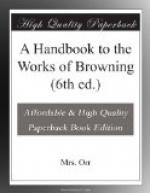[Footnote 87: This spontaneous mode of conception may seem incompatible with the systematic adherence to a fixed class of subjects referred to in an earlier chapter. But it by no means is so. With Mr. Browning the spontaneous creative impulse conforms to the fixed rule.
The present remarks properly belong to that earlier chapter. But it was difficult to divide them from their illustrations.]
[Footnote 88: First in “Hood’s Magazine.”]
[Footnote 89: I may venture to state that these picturesque materials included a tower which Mr. Browning once saw in the Carrara Mountains, a painting which caught his eye years later in Paris; and the figure of a horse in the tapestry in his own drawing-room—welded together in the remembrance of the line from “King Lear” which forms the heading of the poem.]
[Footnote 90: Instances of it occur in the “Dramatic Idyls” and “Jocoseria;” and will be noticed later.]
[Footnote 91: Generally confounded with his contemporary and fellow-citizen, Girolamo del Pacchia.]
[Footnote 92: The (Baron) Kirkup mentioned at vol. xiv. page 5 was a Florence friend of Mr. Browning’s, and a connoisseur in literature and art. He was ennobled by the King of Italy for his liberal views and for his services to Italian literature. It was he who discovered the portrait of Dante in the Bargello at Florence.]
[Footnote 93: Nets spread to catch quails as they fly to or from the other side of the Mediterranean. They are slung by rings on to poles, and stand sufficiently high for the quails to fly into them. This, and every other detail of the poem, are given from personal observation.]
NON-CLASSIFIED POEMS (CONTINUED).
MISCELLANEOUS POEMS.
Even so imperfect, not to say arbitrary, a classification as I have been able to attempt, excludes a number of Mr. Browning’s minor poems; for its necessary condition was the presence of some distinctive mood of thought or feeling by which the poem could be classed; and in many, even of the most striking and most characteristic, this condition does not exist. In one group, for instance, the prevailing mood is either too slightly indicated, or too fugitive, or too complex, or even too fantastic, to be designated by any term but “poetic.” Others, again, such as songs and legends, depict human emotion in too simple or too general a form, to be thought of as anything but “popular;” and a third group may be formed of dramatic pictures or episodes, which unite the qualities of the other two.
In the first of these groups we must place—
“The Lost Leader.”
("Dramatic Lyrics.” Published in “Dramatic
Romances and Lyrics.”
1845.)
“Nationality in
Drinks.” ("Dramatic Lyrics.” Published
as
“Claret and Tokay,”
without 3rd Part, in “Dramatic Romances
and Lyrics.” 1845.)




